I wish this feature the from USSOCOM were longer, but it offers some great insight into an SF legend, LTC Bucky Burrus, a founding member of the Army SMU and a very well deserved recipient of the 2025 Bull Simon Award.
I wish this feature the from USSOCOM were longer, but it offers some great insight into an SF legend, LTC Bucky Burrus, a founding member of the Army SMU and a very well deserved recipient of the 2025 Bull Simon Award.
WASHINGTON, D.C. — As the U.S. Army celebrated its 250th anniversary June 14 with a birthday festival and parade in the nation’s capital, the U.S. Army Corps of Engineers was hard at work behind the scenes and on the logistical front lines. In a powerful intersection of history and engineering excellence, USACE’s contributions helped ensure parade success while also symbolizing its own 250th anniversary of building and defending the nation.
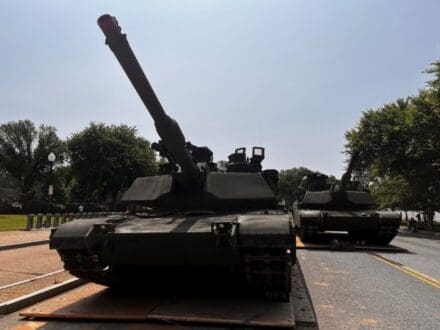
Just two days later, June 16, USACE marked its own 250th anniversary, dual milestones that illustrate the organization’s longstanding role in supporting the nation and the warfighter.
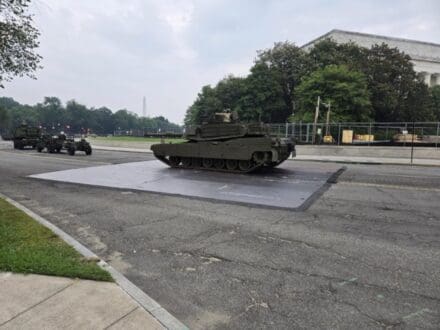
“Army engineers have served and strengthened America since 1775,” said Lt. Gen. William “Butch” Graham Jr., USACE commanding general and 56th Chief of Engineers. “We are proud to carry on that legacy as we continue engineering solutions to the nation’s toughest challenges.”

Protecting the Parade Route: USACE Baltimore District installs protective plating
One of the parade’s logistical challenges was how to safely operate heavy tracked vehicles like the M1 Abrams main battle tanks, M2 Bradley Fighting Vehicles, M109 Paladins and M88 Hercules recovery vehicles through the heart of Washington, D.C. In particular, the Abrams, weighing more than 140,000 pounds and nearly 30 times the weight of a standard SUV, could have posed a risk to city streets, especially at any turning points where tracked vehicles must pivot, creating added stress and friction on asphalt.

To help protect the parade route, USACE Baltimore District spearheaded the installation of metal plating at critical 13 pivot points along the route. These protective measures ensured that turns and idling points where tracked vehicles exert the most pressure would not result in damage to the roads.
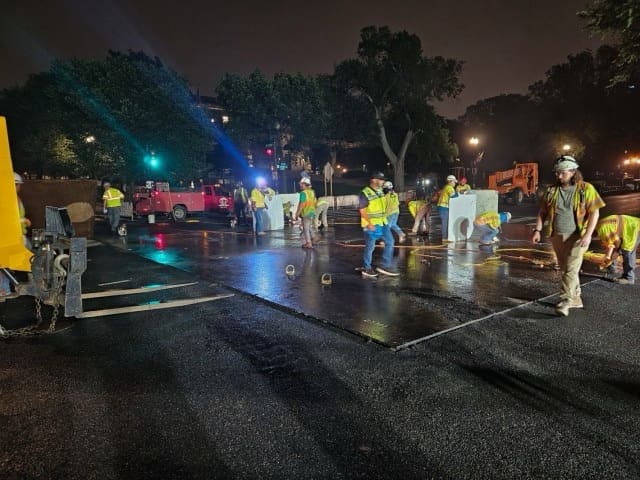
“The infrastructure protection plan was a success,” said Baltimore District Commander Col. Francis Pera. “Close coordination with partner agencies allowed us to honor our rich history while preserving the structural integrity of D.C.’s roadways.”
Plate removal was complete by June 17 and officials determined the protective plates performed as intended. Subsurface inspections will also be completed in the coming weeks in conjunction with the NPS.
Beyond the protective plating, other key precautions included installation of new rubber track pads on all tracked vehicles to avoid the stresses of direct metal-on-pavement contact, and slow driving speeds that allowed vehicle crews to exercise maximum caution as they moved along the route.
Geospatial Precision: AGC mapping supports parade safety and planning


Beyond road protection, the Army Geospatial Center (AGC) played a crucial role in assessing the parade route through geospatial analysis. The Geospatial Visualization Team (GVT) from the Warfighter Support Directorate’s Engagements Branch conducted ground-based video reconnaissance both before and after the Army’s 250th Birthday parade to support damage assessments and potential repair planning.
Using vehicle-mounted cameras, the team captured more than 155 gigabytes of high-resolution 4K video from both the front and rear perspectives of the route. Engineers then reviewed and analyzed the footage to identify any signs of road damage directly linked to the movement of tracked and heavy wheeled Army vehicles.
Keeping the Mission on Track: ERDC optimizes vehicle transport
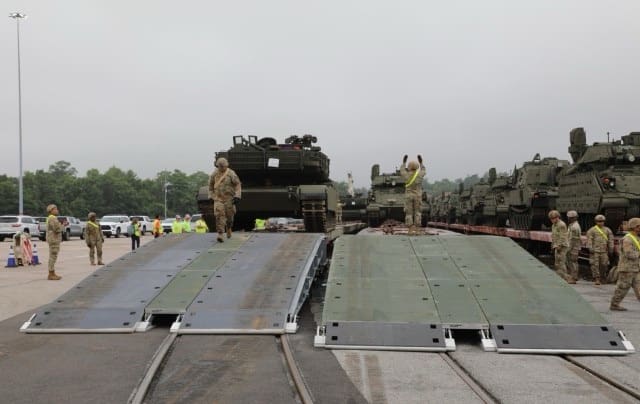
Further north in Jessup, Maryland, the U.S. Army Engineer Research and Development Center (ERDC) played a pivotal role in the logistical success of the parade. With just hours to offload more than 60 heavy combat vehicles, engineers turned to ERDC’s Rapidly Available Interface for trans-Loading (RAIL) system, a mobile solution built to speed up rail operations while reducing manpower and safety risks.
“The RAIL system for rail ops proved 100% critical for timely operations,” said Col. Brandon Perdue, NORTHCOM Plans Team chief. “This system reduced download and upload times from about 2.5 days on both ends to just a few hours. Without this system, the only option for tracked vehicle download was a single crane.”
The modular RAIL system was designed to offload military vehicles at any point along a rail line, providing greater operational flexibility to quickly move combat power where and when it’s needed most. Two RAIL systems were used to simultaneously unload the various tracked and wheeled vehicles. Soldiers received onsite training from ERDC experts, proving how the organization’s innovation directly supports mission readiness and modern solutions.
Building the Nation, Supporting the Army
As the U.S. Army Corps of Engineers continues celebrating 250 years of service to the nation, the role of Army Engineers remains vital. From battlefield engineering in the Revolutionary War to modern-day infrastructure, mapping and mobility solutions, Army Engineers continue to deliver solutions to the nation’s toughest challenges.
By MAJ Spencer Garrison and Kathryne Gest

LIVE ACTION – Soldiers train with synthetic Claymore mine, mortar, grenade and Stinger weapons systems to determine if they accurately portray a live-fire weapon during an operational demonstration of the STE LTS at the Joint Readiness Training Center, Fort Johnson, Louisiana in January 2024. (Photo by Ariana Aubuchon, PEO STRI)
Haptics improvements to Army simulation training makes virtual environments feel more realistic.
Simulation doesn’t replace live training, but with enhancements to its digital programs, along with haptics improvements, the Army will soon be able to augment existing programs and replicate weapons like direct fire, counter-defilade and directed energy that, until now, couldn’t be replicated through simulation. Making interactions with virtual environments or digital devices feels more realistic and tactile.
Haptics is the use of technology to simulate the sense of touch by applying forces, vibrations or motions to the user via wearable suits or devices (i.e., gloves, vests, watches). While it is not currently used in live force-on-force training—a training method that combines live action with virtual and constructive training—it will be used going forward to bridge the gap between virtual training and real-world experiences. The result is a safer, more effective and more cost-efficient way to prepare Soldiers for various operational scenarios, and this technology is particularly valuable in effectively addressing modern military challenges—from urban warfare to cyber-defense training.
“Haptic technology in combination with immersive VR/AR [virtual reality and augmented reality] technologies and artificial intelligence [AI] form a critical architecture element within emerging Army training systems,” said Chief Technology Officer Marwane Bahbaz, Program Executive Office for Simulation, Training and Instrumentation (PEO STRI). “And simulations using virtual reality and haptic capabilities drastically increase immersion and improve retention and learning in training exercises.” This means that Soldiers can safely and effectively practice high-risk or complex scenarios like piloting a plane or handling dangerous machinery with more confidence and less risk than in real life.
He explained that haptics “increases combat realism in the collective training environment because it induces combat stress to Soldiers, ensuring that the execution of the mission, the decision-making process and the overall combined arms tasks are validated.” Inducing combat stress in the training environment mimics the emotions and fatigue Soldiers could face when engaged in combat so they are better able to anticipate these sensations in the peer threat environment.
The Synthetic Training Environment Live Training System (STE LTS), which uses virtual technology to simulate combat environments for Soldiers, is advancing haptic technology with environmental hardening (increasing resistance to stress or threats) to enhance training resilience and cost efficiency and continues to monitor and invest in evolving haptic innovations.

REAL-WORLD BENEFITS – A Soldier from the 1st Battalion, 509th Infantry Regiment, takes part in an operational demonstration of the Synthetic Training Environment Live Training Systems (STE LTS), designed and fielded by PEO STRI, at the Joint Readiness Training Center at Fort Johnson, Louisiana. STE LTS allows Soldiers to take part in more reps and sets than they would with live fire, while reducing training costs and improving safety. (Photo by Ariana Aubuchon, PEO STRI)
SYNTHETIC TRAINING ENVIRONMENT
In 2017, the Army began developing the Synthetic Training Environment (STE) with the goal of achieving initial operational capability by 2021 and full operational capability (a highly realistic and immersive training environment) by 2023. Some features are currently being used for training, while the full system is still under development and deployment.
The STE integrates virtual reality and augmented reality to create immersive, realistic training scenarios across multiple domains—land, sea, air, space and cyber. By enhancing training with VR and AR, Soldiers can experience complex, large-scale environments and situations that are difficult or impossible to replicate in live training, improving readiness, decision-making and coordination in a cost-effective manner.
“The vision of the Army’s Synthetic Training Environment is to revolutionize Army training by merging live, virtual, constructive [LVC] and gaming platforms into an interoperable training experience that provides real-life immersion for combat training,” said Bahbaz. The blending of these domains enables decentralized training, reduces wear on tactical equipment and provides additional tools to enhance training effectiveness. This provides significant value for brigade and company-level training, benefiting forward observers (fire support specialists, artillery observers) and mortarmen crews.
PEO STRI’s Project Manager Training Devices (PM TRADE) has developed instrumented mortars capable of engaging targets across the LVC spectrum, Bahbaz explained, including live instrumented Soldiers, the virtual Training Simulation Software (TSS) Soldier and constructive simulation-generated entities. Using an immersive VR headset, the forward observer can visualize the entire battlefield in real-time, seeing LVC entities in their exact locations. The device provides a fully virtualized view of the battlefield, using high-resolution, three-dimensional terrain models that are updated in real time—allowing the forward observer to pan and zoom the digital battlefield, provide targeting information and call in indirect fire on targets across the LVC spectrum. This capability, he said, allows for a highly realistic and dynamic training environment and can be used to supplement training when live personnel or vehicle platforms are unavailable.
These haptic technologies are currently in the prototyping phase, where the performance and effectiveness is evaluated in a live training environment through the use of Soldier touch points conducted throughout a wide range of locations, including Fort Cavazos, Fort Benning, Fort Irwin, Fort Bragg, Fort Wainwright and Fort Polk. Bahbaz noted that, as a result of the PEO STRI touch points, PM TRADE received both positive and constructive feedback from Soldiers, which was critical in informing requirements and design improvements.
Bahbaz anticipates that these capabilities will be procured in fiscal year 2025 and fielded, starting in fiscal year 2026, to the Combat Training Center sites. This will begin with the Joint Readiness Training Center at Fort Johnson, Louisiana, then the National Training Center at Fort Irwin, California, followed by the Joint Multination Readiness Center in Hohenfels, Germany.
PM TRADE will start fielding with the indirect fire mortar and artillery training systems, he said, followed by shoulder-launched munitions and others, mainly because they enhance realism by providing tactile feedback for recoil, loading and firing, which helps develop muscle memory and operational skills.

STING OPERATION – The Stinger training system, which is being developed by Program Executive Office for Simulation, Training and Instrumentation (PEO STRI) as part of the STE-Live Direct Fires program, provides realistic and immersive training for Soldiers. (Photo by Ariana Aubuchon, PEO STRI)
LIVE TRAINING
For the next generation of dismounted Tactical Engagement Simulation Systems (TESS)— designed for infantry or ground-based personnel to simulate real-world combat scenarios without live ammunition—PEO STRI is prototyping haptic alerts to the Soldiers for firing, near miss, wound assessments and suppression.
“The current Live Tactical Engagement Simulation Systems use audio alters for near miss and assessment, which also provides an alert to nearby opposing Soldiers,” said Mark Dasher, product lead for STE LTS. “Use of haptics will provide a silent alert when battlefield effects occur. Additionally, tactical haptics will introduce new training capabilities such as loading ‘training round’ into a 155 mm howitzer.”
During live force-on-force training, the integration of artificial intelligence and machine learning (AI/ML) is going to be a key focus area for live prototyping efforts at many levels, Dasher said. For this training, real Soldiers, using real equipment in physical environments, engage in simulated combat against other live participants—with the addition of synthetic computer-generated elements to enhance realism and complexity. “First, we are applying AI/ML in engagements allowing proper combat techniques [e.g., target lead and site elevation],” Dasher said. This will provide real-time, data-driven feedback, as AI creates moving targets and realistic conditions, while ML adapts training to individual skill levels, analyzing performance to refine accuracy and decision-making. “We believe that AI/ML will provide a continuous evaluation of Soldier and unit actions, enabling better unit training strategies. In the future, AI/ML will support small-unit training without the need of trainers, exercise control, OPFOR [Opposing Forces] or external enablers.”
Live training systems are utilized not just by the Army but also by other services, particularly the U.S. Marine Corps (USMC). “We work closely with PM TRASYS [Program Manager for Training Systems], our USMC counterparts in modernization efforts,” Bahbaz said. “They participate in our Soldier touch points and provide valuable feedback to our team.”
Bahbaz said PEO STRI has also forged a solid partnership with the Program Executive Office for Intelligence, Electronic Warfare and Sensors Project Linchpin, the Army’s first artificial intelligence pipeline to deliver AI and ML capabilities to sensors for faster and more accurate decision-making in collaboration with the STE cross-functional team.
“We have successfully released, jointly, a request for information that communicates AI needs for Army training. This is part of our STRI to efficiently accelerate AI adoption across the training portfolio and specifically in [the] STE program, starting with live.” Bahbaz said he received 82 responses spanning traditional (defense-focused industries) and non-traditional (commercial business with advanced commercial technologies, particularly in the digital space) with diverse experience, which will expand—even transform—the Defense Industrial Base. “This market research effort will shape the prototyping requirements of our modernization programs with respect to AI and data,” he said.
PEO STRI, Bahbaz said, is also investing in computer vision technology as a potential replacement for lasers currently used by the Instrumentable Multiple Integrated Laser Engagement System (I-MILES), a system that enables the Army to simulate combat and improve the realism of training.
“Object detection will enable us to simulate physics-based direct fire engagement, further increasing the realism in the live training environment,” Bahbaz said, adding that recent engineering touch points have yielded promising results as haptic devices attempt to draw reaction of the forces as they maneuver in the force-on-force battle space.
At Soldier Touch Point 10 (a testing session point of refinement), he explained that two haptic devices were tested: 1) a haptic watch that also provided an electronic MILES casualty card to process and display battle damage assessment on their training system in fidelity that allows the performance of exercise medical tasks in a combat training exercise; and 2), a haptic Small Arms Protective Insert replacement, a type of body armor that provides a tactile feedback sensation when impacted by a bullet, allowing the wearer to perceive a hit without feeling the full force.
Bahbaz said PEO STRI is experimenting with these haptic wearables to introduce the effects of explosions that are also integrated with mixed-reality devices and to increase the fidelity of interactions between live participants and synthetic entities in live exercises.
A “STAGES IN STAGES” APPROACH
Bahbaz said there are two live training modern products that will include a “stages in stages” approach, meaning phased in as technology matures and is validated. These two products are the Indirect Fire and Guide System (i.e., Stinger Trainer), with the first increment production planned to begin in fiscal year 2025 and fielding in fiscal year 2027, and the Direct Fire System with haptic and AI-enabled system, which is currently in the prototyping stage and scheduled for production in fiscal year 2027 and fielding in fiscal year 2028-29.
The Stinger Training System provides realistic and immersive training for military personnel, enabling them to effectively operate and maintain the Stinger missile system in a variety of combat scenarios and to simulate the complexities of real-world engagements. This allows users to develop the skills and confidence needed to accurately detect, track and engage enemy aircraft, while minimizing the risks and costs associated with live-fire training.
The system requires the gunner to perform all tasks involved in Stinger operation and target engagement. The life-sized Stinger trainer connects to range instrumentation, delivering realistic training without firing projectiles and can interrogate instrumented aircraft utilizing a simulated Identification Friend or Foe (IFF), replicating the dimensions, weight and firing sequence of a real Stinger weapon system.
A direct fire system with haptic and AI-enabled capabilities is a training platform designed to simulate a realistic use of the weapon in the force-on-force environment. According to Bahbaz, these systems leverage haptics to provide physical feedback, such as recoil, vibrations and resistance, replicating the sensations of real-world weapon handling. At the same time, AI introduces adaptive elements to the training or operational environment, like intelligent target behaviors, real-time performance analysis and scenario adjustments.
For example, a rifle or machine gun training simulator equipped with haptics will simulate the weapons recoil and resistance while engaging AI-controlled targets that react unpredictably to the Soldier’s kinetic actions and reinforce rapid decision-making. The system, Bahbaz said, will provide feedback on accuracy, reaction time and situational awareness, adapting the scenarios’ difficulty as the training environment changes.
These systems utilize AI to simulate lively scenarios like engaging aerial or ground threats, adapting to trainee performance and providing detailed feedback on decision-making and accuracy. Haptics enhancements also add a layer of physical realism by replicating sensations like weapon recoil, weight and control resistance, helping users develop muscle memory and familiarity with equipment. Together, these technologies ensure comprehensive preparation by addressing both the cognitive and physical aspects of weapon operation in a safe, controlled environment.
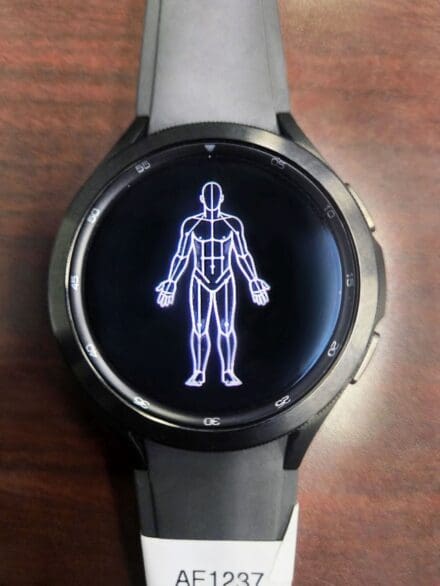
HALF PAST HAPTICS – A wrist-worn device like this watch can be worn by Soldiers to provide situational awareness, biometric data, and a real-time casualty assessment during training. These improvements in haptics will help to provide a more realistic training environment and bridge the gap between virtual training and real-world experiences. (U.S. Army photo, courtesy of PEO STRI)
GOING GLOBAL
U.S. simulation training is conducted globally to enhance interoperability with allied forces, improve mission readiness and adapt to region-specific challenges. These exercises allow multinational forces to train together using advanced technologies, fostering seamless collaboration in joint operations. Simulation training is also cost effective and safer compared to live exercises, enabling realistic practice without the logistical complexities or risks. By deploying this training worldwide, the U.S. not only prepares for diverse operational scenarios but also demonstrates leadership in cutting-edge military technology.
“PM TRADE provides training capability for home station, Combat Training Centers and for use during deployments. Where the Army is, the Army trains. As haptic-enabled TESS is deployed, the Army will use globally as needed,” Dasher said.
“These improvements can be used by our multination partners,” Bahbaz noted. “In fact, we collaborate closely with our Five Eyes [Oversight and Review Council composed of intelligence oversight, review and security entities of Australia, Canada, New Zealand, the United Kingdom and the United States] on several live training technologies. They are well informed of the core design of training capabilities and have various engagements [where] we exchange our lessons learned to ensure interoperability.”
CONCLUSION
Improving haptics within the STE offers significant benefits for enhancing the Army’s training capabilities. These advancements create a more immersive and realistic training experience by bridging the gap between virtual scenarios and visual sensations. Wearables enable real-time biometric feedback, which can improve training effectiveness by monitoring Soldier performance, stress levels and physical conditions. Enhanced haptics deliver tactile and force feedback, allowing Soldiers to experience the sensations of weapon recoil, environmental resistance and physical impacts while fostering muscle memory and situational awareness. By integrating these technologies, the STE not only better replicates real-world conditions but also reduces the logistical burden and cost of live training exercises. This comprehensive approach ensures that Soldiers are better prepared for operational challenges, leading to improved readiness, adaptability and mission success.
“A critical resource is time for units to train, especially at the lower level (e.g., squad or platoon). Through the insertion of new technology, STE LTS is creating training devices that are both easy to use and realistic,” Dasher said. “The benefit of these enhancements and new additions is allowing units to do realistic training, anywhere and at any time.”
For more information, go to www.peostri.army.mil
By Cheryl Marino for Army AL&T Magazine
CHERYL MARINO provides contract support to the U.S. Army Acquisition Support Center at Fort Belvoir, Virginia, as a writer and editor for Army AL&T magazine and TMGL, LLC. Prior to USAASC, she served as a technical report editor at the Combat Capabilities Development Command Center at Picatinny Arsenal for five years. She holds a B.A. in communications from Seton Hall University and has more than 25 years of writing and editing experience in both the government and private sectors.

The Carl Gustaf Multi-Role Anti-Armor Anti-Personnel Weapon System (MAAWS) is a remarkable weapon system for light infantry forces. But this weapon is also one of the least understood systems across the Infantry.
The 84mm Recoilless Rifle goes by many nicknames: Carl G, the Gustaf, the Goose, MAAWS, the M3. Whatever you call it, it looks like a beast, and one glance tells you that it packs a punch. Yet the uninitiated mistake the Carl G as little more than a reloadable AT4 so it still gets driven like an old station wagon when it has the performance, versatility, and power of a race car.
The new M3A1 MAAWS with the integrated fire control system (FCS) is so capable, it’s almost cheating… but only if our gunners — and our leaders — understand all that it is capable of and how to employ it. The Carl G deserves to be more than a show pony that sits in the arms room, neglected.
The M3A1 Carl Gustaf is the most powerful weapon system in a rifle platoon. As the Army searches for ways to increase the lethality of the infantry brigade combat team (IBCT), one of the solutions is already sitting quietly in our arms rooms, waiting to get the attention it deserves.
A Natural Recipe for Neglect
There are two compounding reasons why the Carl G gets overlooked and has yet to truly infuse itself into the light infantry ethos. The first is a general lack of familiarity or exposure to the weapon among maneuver leaders. Few saw the original M3 in action in Iraq or Afghanistan due to its limited fielding (mostly across special operations forces [SOF]), and even less have seen the new M3A1 perform with the integrated digital optic, which completely changes the consistency and accuracy of the weapon by an exponential factor.
The second is a gross lack of available training ammunition (sub-caliber 7.62mm training rounds or full caliber training practice [TP] rounds) to build the needed appreciation for the weapon. What can we expect in terms of proficiency or confidence in our weapons when we give our gunners the minimum required rounds yearly to train with? The answer: a day familiarization that, at best, helps teams hit a static target at 300 meters during the day, which is what we can expect from an AT4. The M3A1, however, can hit targets beyond 1,000 meters day or night. The FCS can immediately calculate the speed of a moving target and show the gunner where to aim to hit that target while moving. And, if given high explosive (HE) 441 rounds to train with, our gunners can learn how to select airburst so the rounds explode over troops in the open at up to 2,000 meters behind defilade.
The Carl G will be one of the most impactful weapons for American light infantry forces in the next major war… but only if we can learn how to employ it! The goal of this article is to help leaders gain a true appreciation for the power and versatility of this weapon system. It explains some of the critical capabilities that the new M3A1 provides when paired with its optic, the Fire Control System 13-Rate Estimator (FCS13-RE). Lastly, this article shares recommendations for how to update the marksmanship training progression for the M3A1 MAAWS to build both individual gunner proficiency and leader familiarity with what the system offers our infantry platoons and squads fighting across rugged and restrictive terrain.
To see a marked improvement, we just need to expand our understanding of what it offers and provide our gun teams with significantly more training ammunition to build proficiency for both day and night against static and moving targets at distance. As this article will explain, however, the ammunition change is not a big ask. In the end, there might not be a better return on investment for the Army than making long-overdue updates to the M3A1 training ammunition allocation.


Advancing the Original M3 to the New M3A1 with Digital Fire Control System
SOF has had the greatest appreciation for the Carl G since the 75th Ranger Regiment first acquired the M3 in 1989. The recoilless rifle made regular appearances over the last three decades at platoon live fires where gunners took turns trying to knock out bunkers at plus-or-minus 400 meters at night with TP rounds. When the M3 team hit the bunker, it would be spectacular — one shot and the bunker was neutralized, probably collapsed. And that was just from the “concrete” practice round. It was easy to imagine what a real HE round would do.
Those were the highlight reel moments, however. For every bunker hit, there were repeated misses, especially when the targets were small or further out. Rounds would often quietly sail over the horizon, leaving the assaulters doubting whether their gunners would manage that shot in a two-way firefight.
Rangers and IBCTs just finished the full fielding of the new M3A1 and the integrated digital FCS (FCS13-RE) in October 2024. The days of repeated missed shots quietly sailing over the horizon or impacting ineffectively just shy of the target are over. The new M3A1 paired with the FCS is the difference between a flip phone and a smart phone. Technically, they both text, take pictures, and make calls, but there’s no comparison to the functionality, speed, and qualitative difference between the two. If you are old enough to remember T9 texting, then you’ll understand the comparison here of how much faster and effective it is to acquire and engage targets with the M3A1 and FCS than with the original M3 and manual sights.
Why the FCS13-RE Changes the Game for the Carl G
There are a host of challenges to hitting a target with a recoilless rifle. Each munition type has its own ballistics, and they fly differently based on the type (from TP or TP with tracer [TPT] to smoke, HE dual-purpose [HEDP], and HE anti-tank [HEAT]). They also fly differently based on the altitude, the ambient air temperature, as well as the temperature of the round’s propellant (where/how the round is stored before firing). Point of aim on iron sights will not be point of impact. Original M3 gunners had to learn their holds at different distances for each type of round, and only experience with each round taught gunners their holds. And all of it would be an estimation at best. Mounting a Storm Laser Range Finder could help M3 teams factor the distance to set in 50-meter increments on their manual cam wheel dials with luminescent rings, but that was only one factor. Adjusting points of aim for the altitude as well as the air and powder temperature could also become a guessing game best left alone when firing the original M3.
The new M3A1 does more than shave seven pounds and three inches in length from the original M3. The M3A1 with FCS13 is a full-fledged computer that will make an old Goose gunner sick with envy. It’s a true fire control system that accounts for all the confounding factors that used to cause gunners to miss those critical shots. Even the improved backup reflex sight (BRS) on the M3A1 is an improvement from the original M3 fire control knobs.
The FCS13-RE is capable of both day and night operations. The red dot is compatible with our individual night vision systems so there’s no need to change optics or viewing devices from day to night operations. Gunners can tell the computer the altitude, outside temperature, and temperature the ammunition is stored at, and the computer immediately factors all those variables into the point of aim for the gunner.
The FCS13-RE is a modular ballistic computer capable of holding more than 50 ballistic solutions for different MAAWS munition types. Gunners can select up to five quick access types prior to going on mission for rapid selection during an engagement. The key for training is to identify the FCS13-RE’s menu selection for the sub-caliber rounds (listed as “SCA” for sub-cal adapter or “7.62” in the FCS13 menu depending on the software version) to select the right ballistics for TP and TPT rounds (they are distinct). In the event any new munitions are not present in a unit’s version of the FCS, a quick software update can be uploaded to the computer.
The FCS13-RE’s built-in laser range finder (LRF) calculates points of aim for both static and moving targets. A single press of the LRF measures the point of aim on a static target. When gunners press the LRF for more than two seconds, the fire control will calculate a moving target solution utilizing an on-board gyro and multiple pulses of the laser. The optic then provides both a target lead point as well as the hold for the gunner based on the target’s calculated speed and distance along with the ballistic performance of the selected munition type. The gunner then just matches their red dot to the optic’s aimpoint and fires. It’s a remarkable feature but one that can only be mastered through repetitions and practice under a host of scenarios involving various firing positions, speeds, distances, and visibility conditions.
The Versatility of the MAAWS
The MAAWS is so much more than an anti-tank weapon. The menu of munition types allows rifle platoons to employ the Carl G for a variety of functions; however, it is often characterized as a light and medium anti-tank system because of the limited munition types the U.S. Army keeps in its inventory. The U.S. Army currently fields the High Explosive Dual Purpose 552 cartridge which can defeat light armor and personnel. It can be employed for either impact or delay mode. The U.S. Army also fields the High Explosive 441D cartridge which has a timer on the front of the cartridge for airburst above targets in defilade. The Army fields two training munitions: the 7.62 Sub-Caliber Adapter 553 system and the full caliber Target Practice Tracer 141 training cartridge.

There are a breadth of munitions variants already in production that other partner nations (and U.S. Special Operations Command) maintain. A High Explosive Anti-Tank 551C Reduced Sensitivity cartridge with tandem warhead can destroy main battle tanks equipped with Explosive Reactive Armor (ERA). An Anti-structure Munition 509 (ASM) can destroy bunkers and small buildings with a thermobaric warhead. A Multi-Target 756 cartridge can defeat targets behind concrete walls with a tandem warhead. Smoke rounds can provide thick, high-concentrated obscuration on demand for assaulters moving across exposed objectives more than 1,000 meters away.
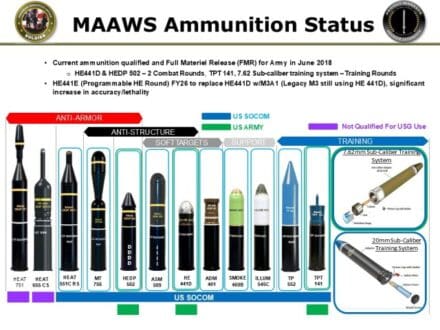
The airburst option using HE rounds is one of the MAAWS’ critical capabilities; however, few gunners or leaders have the opportunity to gain familiarity with employing this effect. None of the training munitions can replicate the airburst option, only point detonation. The only way to become proficient with this feature is to provide MAAWS teams with HE rounds to train with. The proposed Standards in Training Commission (STRAC) allocations in this article recommend two HE rounds per year for gunners to train with.

Unlike the M3, the M3A1 also has a built-in fire control unit that can connect the FCS13-RE with the rounds loaded in the tube, allowing gunners to employ advanced munitions like the improved HE 441E on airburst mode. The older HE 441D model requires assistant gunners (AGs) to manually set the nose cone of the round to explode at the selected distance and also discharges steel balls on either point detonation or airburst (as opted by the AG) up to 1,200 meters away. The new “E” variant maximizes muzzle velocity to extend its range of a greater payload of metal spheres that improves the spread pattern upon impact or airburst.
Units with the original M3 should only receive HE 441D rounds since the original M3 launchers do not have a fire control unit to add digital instructions to the loaded munition. As the U.S. Army acquires the new HE 441E round, IBCTs should receive a minimal amount of these rounds to train with — to appreciate the effects of the munition, employ it under both day and night conditions, and see how the FCS13-RE adds the airburst option for the 441E round only once the tube detects that variant in the launcher. Gunners cannot even practice selecting the airburst option in the menu controls until the M3A1’s fire control unit reads the round in the tube. So dry training or TP rounds do not allow gunners to familiarize themselves with the steps to employ the HE 441E on airburst mode.
Necessary STRAC Modifications

The U.S. Army’s training strategy and qualification approach for the M3A1 does not build sufficient proficiency and experience with the MAAWS. Likewise, the STRAC needs critical, but highly cost efficient, changes to support a proper training progression that lets M3A1 teams fire both day and night at different distances against static and targets.
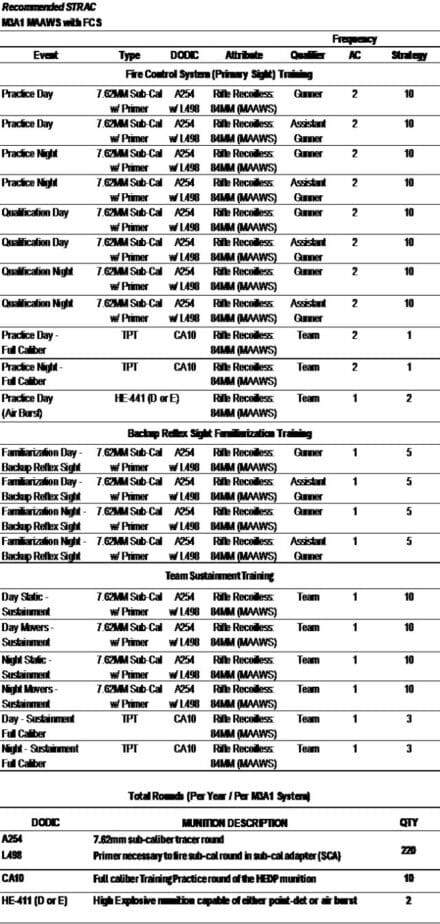
The most important training round to build proficiency is the 7.62mm SCA. The SCA is designed to fire a three-part munition system including a unique (low-grain) 7.62mm tracer round, a primer, and a backblast simulator. The backblast simulator is not recommended for use because it doesn’t accurately represent the major backblast effect of the recoilless rifle but does foul the system. The SCA does not require the backblast simulator so units only use the 7.62mm tracer round and primer when training. Eliminating the backblast simulator saves money to purchase the two essential components of the SCA: the tracer round and primer.
The current STRAC allocates several sub-caliber rounds and a TPT round per M3/M3A1 team for “qualification.” This is a misleading characterization of weapon proficiency. The training strategy borrows from the training strategy of the AT4 using 9mm sub-caliber tracers. But the MAAWS is a crew-served weapon system that has both primary and backup sights. The current STRAC for the MAAWS is equivalent to giving a M240 machine-gun team a 150-round belt of ammunition a year to qualify and train with during live-fire exercises (LFXs). MAAWS teams need to practice and then qualify in four different firing positions (standing, kneeling, sitting, and prone) at various distances (200-700 meters for training rounds), under both day and night conditions. Currently, there are no allocations for night qualification or practice iterations. There are also no designated rounds for AGs to qualify as alternate gunners. If they are to shoot the system, they need to take from the gunner’s sparse allocation. There are also no rounds allocated for the BRS that requires several manual inputs.
A minimum number of rounds to train a gunner and AG (as the alternate gunner) to engage the variety of target scenarios at extending distances in different firing positions would be 10 engagements in a firing table, first through a practice iteration followed by a qualification iteration.
Example firing scenarios:
Position: Standing, Kneeling, Sitting, Prone
Distance: 200m, 300m, 400m, 600m, 700m
Target: Bunker, Tank, Truck, Window
Static: Bunker, Armored Personnel Carrier (APC), Tank, Window
Moving: APC, Tank
Conditions: Day and Night
These practice and qualification firing tables need to be repeated at night by both gunners and AGs. Training with sub-caliber rounds alone would not give teams sufficient familiarity with the sensation of firing a full caliber round or experience with the employment of airburst HE rounds. Therefore, the training strategy needs to include a minimal number of TPT and HE rounds to give teams familiarity with the actual effects of the MAAWS.
The FCS13-RE is the primary sight of the M3A1, but crews also need to be familiar with the BRS. A minimum of five additional sub-caliber rounds would allow for this under day and night conditions.
Light infantry units will also want to include sustainment training for their MAAWS teams throughout a training cycle. This can include either dedicated M3A1 ranges or incorporating the weapon system in collective training events such as support by fire, platoon, and company LFXs. These training events should include both static and moving targets in day and night conditions and consist of mostly sub-caliber training rounds as well as limited opportunities to fire full caliber munitions. The full caliber ensures all members of a maneuver element have experienced the need to avoid backblast areas while firing the weapon and builds confidence in the rifle platoon’s organic firepower.
Exposure to Overpressure and “BOPing Out”
Leaders and MAAWS teams need to understand the issue of overpressure exposure when firing full caliber rounds. Referred to as blast overpressure (BOP), there is a limit of rounds that gunners, AGs, and anyone within 100 meters of the MAAWS can be exposed to each day. Designated allowable number of rounds (ANOR) per day varies by munition type and firing position, but these limitations apply to anyone in proximity of the weapon (not just gunners but assistant gunners and safeties too). When team members or supervisors (e.g., lane safety) reach their limit, they “BOP out” and cannot train until their time requirements pass. The risk of concussion and permanent cognitive damage is high if personnel become overexposed to the overpressure from firing these recoilless rounds. It is up to leaders to track and strictly enforce overpressure exposure.
There are minimal overpressure risks when firing the 7.62mm sub-caliber rounds. This makes the value of increasing the availability of these munitions even greater. Not only are they 1 percent of the cost of a full caliber munition, but the low risk to overpressure also enables teams to get repeated repetitions at firing in different distances and positions against a variety of static and moving target scenarios.
The Value of Virtual Training
Virtual training presents a powerful way to build MAAWS proficiency, similar to the variety of weapons found in indoor Engagement Skills Trainer (EST) facilities available on most installations. Although almost every other weapon is available to Soldiers in our virtual trainers (including M240, AT4, and Javelin), the U.S. Army has not yet chosen to purchase any M3 or M3A1 virtual trainers.

Each indoor MAAWS virtual training system costs approximately $170,000, but these systems offer value in several ways. They allow Soldiers unlimited repetitions at firing the system, eliminating any exposure to overpressure. If the U.S. Army acquired M3A1 virtual trainers that included the FCS13-RE, teams could experiment with all munition types, including HE 441E as well as specialty munition variants not currently available for conventional Soldiers to train with. Virtual training systems should include anti-structure, illumination, smoke, and a variety of anti-armor munitions. Ideally, every major IBCT installation with an EST would add at least one M3A1 virtual trainer. At a minimum, the U.S. Army’s Heavy Weapons Leader Course at Fort Benning, GA, should have a M3A1 virtual trainer to help build its students’ proficiency on the weapon.
Routinely Upgrading M3A1s and FCS13s
Units need to recognize that both the FCS13-RE optic and the M3A1 launcher readily receive software upgrades. This includes adding munition types to the FCS13-RE’s ammunition menu and giving the right software upgrades on the launcher’s fire control unit to send data from the optic to those advanced munitions loaded inside the tube. The new maintenance plan includes training to teach 91F armorers how to make software updates at the unit level.
System Proficiency to Ensure Accuracy
There are a few essential skills that leaders must emphasize before MAAWS teams begin firing. The first is recognizing the importance of following proper boresight techniques, and the second is ensuring gunners understand how to operate the FCS13’s controls.
There is no need to zero the M3A1 prior to firing, but the weapon must be boresighted every time it is taken out to be fired. Boresighting requires both the gunner and AG to work as a team, so both must be proficient at the proper steps. The process is not difficult, but it can’t be shortchanged. It includes inserting the included metal boresight discs in the front and back of the launcher and having the gunner and AG aim both the optic and tube at a specific object 300 meters away from the FCS.
In addition to building diligent proficiency at boresighting, MAAWS gunners must also understand all of the FCS13-RE features and needed inputs. This includes knowing how to update the powder temperature (PTEMP), the altitude, and the ambient temperature (ATEMP) prior to going on mission (or firing at the range). The most important of these three factors is the PTEMP since cold powder burns slower. ATEMP is second only to PTEMP and becomes critical for airburst distance accuracy when firing HE rounds. Once the gunner inputs these measurements prior to going on mission or training, the computer will do all of the math during an engagement.
Gunners and AGs also need to be sure they confirm the precise ammunition type and select the corresponding munition inside the FCS ammunition menu. The abbreviated names are not all self-explanatory so matching the right menu option and munition is essential. The computer does all of the complex ballistic calculations, but gunners are very much in the loop on getting the optic to present the right aimpoint.
As long as MAAWS teams do a proper boresight, confirm the environmental factors, and know simply how to select the appropriate munition prior to firing, the FCS13-RE will do everything for the gunner… except control trigger squeeze. The basic fundamentals of marksmanship will always apply, and that is why updating the STRAC still matters.

Conclusion
The M3A1 is in every IBCT rifle company’s arms room right now, itching to get the attention it deserves. This modernized 84mm recoilless rifle, paired with its new integrated fire control system, defeats armor, illuminates, obscures, and neutralizes threats behind defilade. It provides effects on demand without needing to clear airspace for the close combat force. This article aims to help tactical leaders understand how to employ the system and help the Infantry make overdue revisions to the M3 training strategy and ammunition allocation.
The recommended STRAC adjustments proposed in this article will allow MAAWS teams to build the necessary proficiency to routinely destroy a variety of targets at distance, at night, against static and moving threats. As leaders become more familiar with the features of the system, as well as the necessary crew proficiency in operating the system, we will come to learn how essential the MAAWS is to light infantry lethality.
At the time this article was written, LTC D. Max Ferguson commanded 2nd Battalion, 14th Infantry Regiment, 2nd Brigade Combat Team, 10th Mountain Division. He is a career Infantry officer with six deployments to Iraq, Afghanistan, and West Africa with conventional and special operations units. He recently earned a PhD in public policy through the Army as an Advanced Strategic Planning and Policy Program Goodpaster Scholar.
This article appears in the Summer 2025 issue of Infantry. Read more articles from the professional bulletin of the U.S. Army Infantry at www.benning.army.mil/Infantry/Magazine or www.lineofdeparture.army.mil/Journals/Infantry.
As with all Infantry articles, the views herein are those of the authors and not necessarily those of the Department of Defense or any element of it.
(McLean, VA — July 1, 2025) FN America, LLC is pleased to announce that it has been awarded a $4.9 million contract to supply the U.S. Army with additional FN® M240L medium machine guns. The M240L was originally adopted by the U.S. Army in 2010, after a joint development effort with FN to create a lighter, yet durable, medium machine gun.
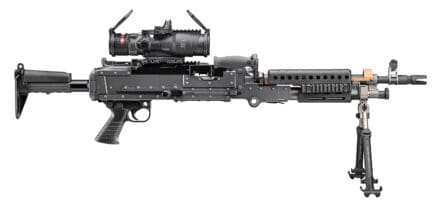
The M240L has been the cutting-edge for lightweight medium machine guns with an overall weight reduction of five pounds from its predecessor, the FN M240B, without any impact to performance or longevity. The 18 percent weight reduction was achieved by incorporating titanium into the design, including the receiver, and introducing new manufacturing methods to adjust for the material properties.
“The M240L continues the collaborative effort between FN, the U.S. Army and the individual soldier to provide the most effective weapon systems for the warfighter,” said Mark Cherpes, President and CEO for FN America, LLC. “The development saw the introduction of new materials along with new manufacturing techniques that have paved the way for the future generation of military equipment. We are extremely proud of this product and look forward to working with the U.S. Army to deliver against this contract.”
The M240 general purpose machine gun (7.62x51mm NATO), derived from the FN® MAG 58, was adopted by the U.S. military in the late 1970s, and has been in continual service since being introduced. FN has created multiple variants of the M240, including the M240 coaxial, the M240B, M240L, M240D and M240H models.
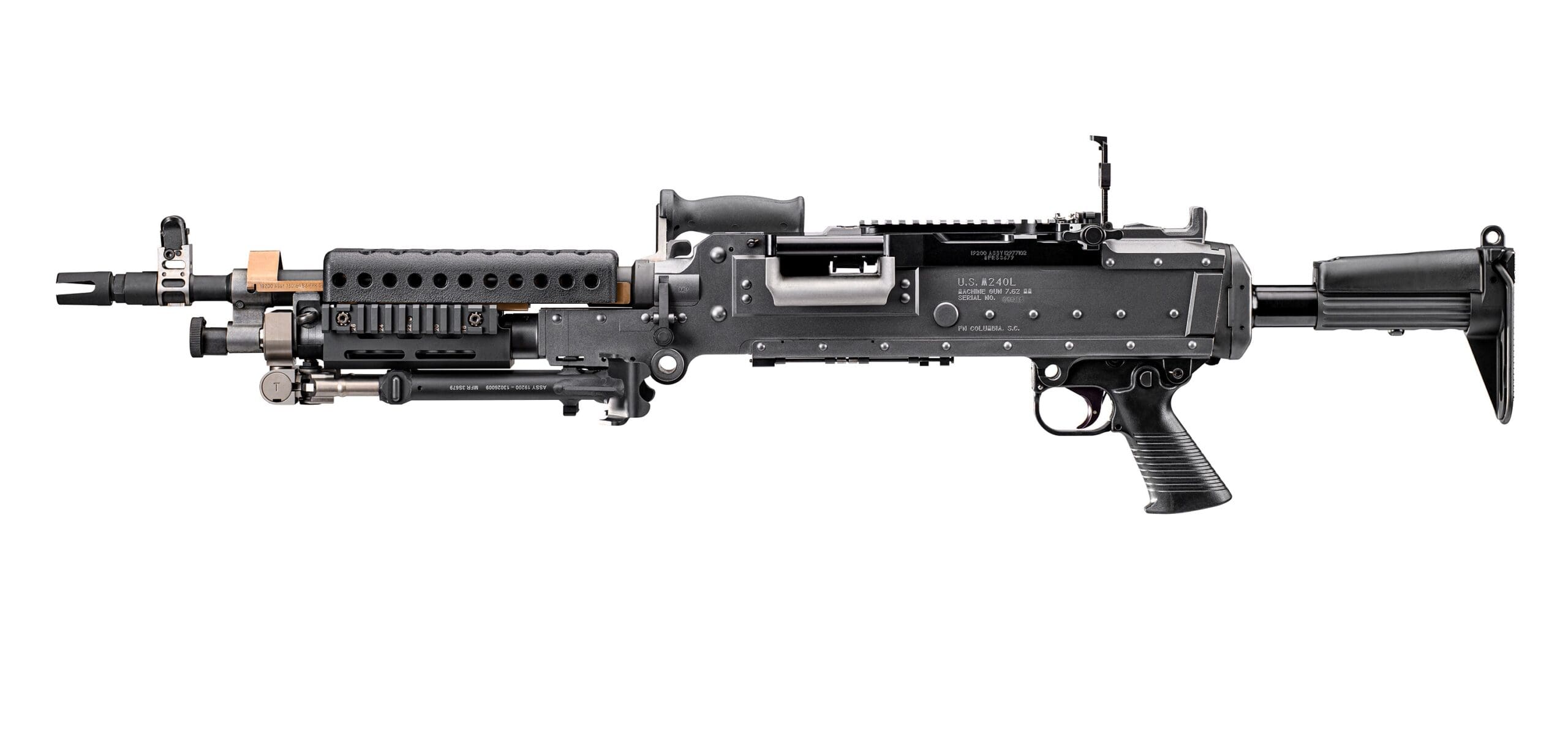
Throughout its history, FN has been one of the largest suppliers of small arms to the U.S. military and continues to develop innovative, future technology. In addition to the M240 and its variants, the company currently holds contracts for the FN® M249 lightweight machine gun; the FN® MK 46, MK 48, MK 17 and MK 20 SSR for USSOCOM and various other contracts.
For more information about FN’s military product line or current U.S. military contracts, please visit www.FNAmerica.com.
ROCK ISLAND ARSENAL, Ill. — On back-to-back days in mid-June, Lt. Gen. Chris Mohan, Army Materiel Command deputy commanding general and acting commander, visited two of the nation’s most important ammunition production facilities — the Radford Army Ammunition Plant in Virginia and Holston Army Ammunition Plant in Tennessee.
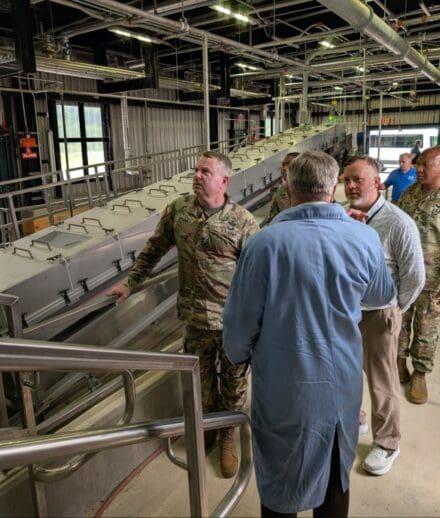
The locations are government-owned, contractor-operated and are two of 18 subordinate installations of the Joint Munitions Command, headquartered at the Rock Island Arsenal in Illinois.
Both visits affirmed the Army’s prioritization of a modern, resilient munitions infrastructure. The engagements provided an opportunity to highlight ongoing modernization efforts, industry partnerships, and the challenges facing the U.S. munitions supply chain.
At RFAAP, Mohan received an orientation on the site’s historic and strategic significance, and he toured several key production areas, including the nitrocellulose boiling tub house, solvent propellant lines, the modern nitrocellulose facility, rocket final pack, medium-caliber load assemble pack, and the new state-of-the-art advanced ammunition facility.
“As a large-volume producer of nitrocellulose and a supplier of solventless propellants, RFAAP plays a pivotal role in national defense,” said Lt. Col. Marie Hough, RFAAP’s commander. “The discussions focused on accelerating modernization timelines, the importance of strengthening the munitions workforce, and enhancing collaboration with industry partners to ensure long-term readiness.”
At HSAAP, a large volume producer of explosive material, Mohan took part in a windshield tour through a variety of production areas with stops at the strong nitric acid unloading and storage area, the flashing furnace modernization project, and the melt-cast modernization project building.
“We discussed emerging challenges with strong nitric acid, and federal regulations that could impact production methods,” said Jeff Worley, the deputy to the commander at HSAAP. “Lt. Gen Mohan encouraged us to seek creative solutions through ongoing dialogue with Department of Defense leadership and regulatory agencies. Transparent and clear communications with state and federal agencies are critical for continued success.”
By Matthew Wheaton, Joint Munitions Command, Public and Congressional Affairs

REDSTONE ARSENAL, Ala. – On the path to becoming a more data-centric organization, Army Materiel Command is leaning into advanced analytics and artificial intelligence, or A3I, to improve its operations.
“Data is no longer just a support function, it’s central to everything we do,” said Lt. Gen. Chris Mohan, AMC deputy commanding general and acting commander. “Our focus on A3I is about empowering our people to make smarter, faster decisions and deliver readiness with greater efficiency.”
Leveraging A3I demonstrates how the command is moving past simply collecting data from fragmented systems to proactively anticipating and solving challenges.
Existing Army systems, while individually capable, often operate in silos, lacking the interoperability needed for a comprehensive view of materiel readiness and limiting AMC’s ability to efficiently move and sustain operations. This is particularly critical given AMC’s complex mission set, which includes everything from ammunition production and vehicle maintenance to sustaining the Army’s global logistics operations.
In 2020, the Army acquired Vantage, integrating the data from systems like GCSS-Army and GFEBS into a unified analytics platform.
This paved the way for the “agility layer,” according to Dr. Chris Hill, AMC chief data and analytics officer and director of the AMC Analysis Group. The agility layer allows AMC employees to build their own apps and tools using the data in Vantage – helping them improve processes, streamline workflows, make better decisions, be more efficient, and ultimately improve the Soldier experience.
The command is already applying this concept with tools like Weapons System 360, which gives leaders a complete look at the Army’s supply chain, and ParaLine, an app that significantly reduces inventory processing time and improves property accountability for Soldiers.
But to fully harness the power of data, leaders believe a fundamental shift in operations is needed, starting with restructuring roles throughout the command. The change isn’t limited to those directly impacting materiel readiness, either, said Hill. Using and understanding and data is now critical for every function within AMC.
“In today’s complex and rapidly changing world, restructuring to fully leverage data is no longer a consideration – it’s a necessity. The benefits of data-driven insights will extend to all directorates, enabling more informed decisions and greater efficiency across the entire organization,” Hill said.
An upcoming order will establish data leads in each headquarters staff section who will be responsible for integrating A3I into daily operations. An AMCAG multi-functional team focused on A3I staff integration will support the data leads. Through a “train-the-trainer” methodology. AMCAG will help to build foundational data and analytics skills that allow the data leads to independently automate processes, build tools and dashboards, and leverage artificial intelligence to streamline operations.
While this transformation represents a significant shift for the workforce, early adoption across several AMC subordinate commands has demonstrated the strength of this organizational construct.
“We’re seeing great energy and innovation at our down trace units,” said Hill. “These teams aren’t waiting for direction. They’re identifying their own challenges and using the agility layer to solve them.”
Aviation and Missile Command is using tools like LAP360 to identify potential maintenance needs and supply availability challenges. Tank-automotive and Armaments Command is employing data analytics to predict vehicle failures and optimize maintenance schedules, and Army Contracting Command is leveraging data and implementing AI tools to identify trends and streamline the contracting process.
As AMC continues to unlock the potential of its data and workforce, this internal momentum will be key to supporting the mission, said Hill. A data-centric transformation is already gaining traction throughout the command, evidenced by an A3I insignia, created by Dr. Chelsea Jones, an operations research analyst in the AMCAG.
The A3I insignia will be featured on internal products to demonstrate the command’s commitment to driving sustainment, readiness and efficiency through data-driven innovation.
“This is about empowering our people to solve problems in new ways and more efficiently,” said Hill. “The A3I insignia is a reminder that data is now at the heart of everything we do.”
By Alyssa Crockett
(FORT LEAVENWORTH, Kansas) — The Peacekeeping and Stability Operations Institute (PKSOI) was recently redesignated as the Security Force Assistance and Stability Integration Directorate (SFASID), and with the name change comes an expanded mission set.

Since its creation in 1993, SFASID has undergone SEVERAL significant restructuring events. Recognizing the need and requirements for forces able to conduct peacekeeping operations, the U.S. Army Peacekeeping Institute was formed to directly address the operating environment our forces were involved at the time such as Haiti, the Balkans, and Africa.
“There is a universal understanding of why the United States Army must be prepared for combat, but there is an equally compelling reason why the Army, the Joint Force, and our allies and partners must also prepare for stability activities that include consolidation gains during combat, setting the theater in competition, and conducting peace operations for collective conflict management,” said T.J. Moffatt, SFASID deputy director. “These DOTMLPF-P requirements all reside now in one Army organization.”
In 2005, after action reports from Iraq and Afghanistan helped the Army recognized the need for doctrine, training, and expertise in stability operations. The institute was renamed to PKSOI, and stabilization doctrine was added to their portfolio. PKSOI was reorganized again in 2019 to consolidate Irregular Warfare (IW) and Security Force Assistance (SFA) at Fort Leavenworth. PKSOI was realigned as a Direct Report Unit to the United States Army Combined Arms Center Commander, but remained at Carlisle Barracks, Pennsylvania, to continue its work as the formal, Secretary of Defense and Secretary of the Army directed lead as the Joint and Army Proponent for Stability and Peace Operations.
In 2022, IW Proponency was reassigned to the United States Army Special Operations Command, aligning the Security Forces Assistance Proponency (SFAP) under Mission Command Center of Excellence. With PKSOI and SFAP working in complimentary mission sets, the SFA Proponency was assigned to PKSOI. This reorganization shifted manpower back to Carlisle Barracks while creating an organization that more effectively supported the SFA Command, the Brigades, Theater Army Commanders, and the Geographic Combatant Commanders.
With the addition of this new mission, PKSOI underwent an internal reorganization in late 2024 that reflected a focus on SFA and Stability Operations concepts, doctrine, training, education, exercises, and policy. Peacekeeping is still in the portfolio and remains as one of the primary missions under stability operations, but the culmination is a name change to SFASID that accurately reflects the organization’s new mission.
Photo by Jason Bortz
U.S. Army Combined Arms Center